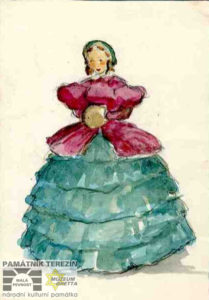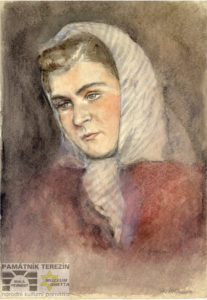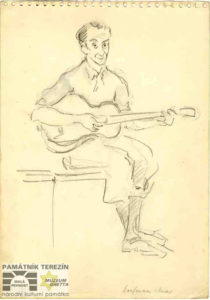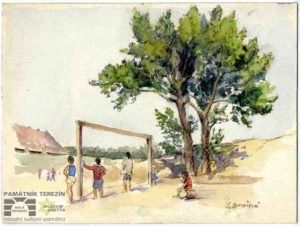
Charlotta Burešová: Girl in a Hoop Skirt, 1942-1945, Památník Terezín, PT 3423, © MUDr. Radim Bureš.
Charlotta (Lotka) Burešová was born in Prague on November 4, 1904 into the family of tailor Gustav Kompert and his wife Steffi. She studied at the Prague Academy of Fine Arts in a class of F. Krattner and at the College of Applied Arts in a class of J. Schusser. She married lawyer Radim Bureš; their only son Radim was born to them in 1927. After the war, son Radim worked as a pediatrician and married lawyer and later well-known Czech politician Dagmar Burešová (who served as the Czech Justice Minister). Before WW II Charlotta fully settled into her husband’s milieu; according to her later words she perceived her identity as follows: “As a matter of fact, before the war I never came into any closer contact with the Jewish community. My husband was ´Aryan´, and so were our acquaintances.“1
After the occupation of Czechoslovakia their marriage was formally dissolved, even though both partners continued to communicate, also during Charlotta´s imprisonment in the Terezín Ghetto, as corroborated by her recollections for the Terezín Memorial recorded in 1972: “One of the gendarmes (his name was Čipera) even mediated contact with my husband. I burnt all those secret letters in Terezín, while my husband has kept the secret messages from me.“1

Charlotta Burešová: Portrait of Hana Kellnerová, 1942-1945, Památník Terezín, PT 5525, © MUDr. Radim Bureš.
Lotka Burešová was taken to Terezín by transport AAs that left Prague on July 20, 1942. Shortly after her arrival she fell seriously ill with an eye disease. After recovery she was employed, also thanks to her artistic training, in a painters´ workshop where she also obtained accommodation after a time. The workshop was situated on the elevated ground floor of the building standing left of the Terezín church (L 410). Her colleagues in the workshop included Otto Kaufmann–Karas who also devoted himself to music and her younger friend Hana Kellnerová. At first, Charlotta painted pictures on tiles according to postcards and later she could go in for free creation. Burešová and Karas also worked on direct orders from SS officers who also used to come to the workshop. Karas applied himself to landscape painting, Burešová to portraiture and figural painting.

Charlotta Burešová: Sketchbook with drawings – Portrait of Otta Kaufmann-Karas, 1942-1945, Památník Terezín, PT 5549, © MUDr. Radim Bureš.
The studios were then moved to Jägergasse 9 where Charlotta lived next to an art restorers´ workshop; two of her Dutch colleagues, Cohen and Morpurgo, were employed there. Works of art confiscated by the Nazis were repaired in the workshop. As for the other artists who lived and worked there, special mention should be made of Jiří Valdštýn–Karlínský. Burešová painted here ten portraits of the Jewish Elders. She made portraits of Benjamin Murmelstein, Leo Baeck and Jakob Edelstein, the latter only according to a photograph.
She was summoned to the SS Command in Terezín in July 1944 in connection with a cause involving a group of artists around Leo Haas and Bedřich Fritta. She was not arrested since her involvement in making the drawings seized by the Nazis had not been proved. From that moment until the end of the war her direct superior was the Dutch caricaturist Jo Spier.
Charlotta took part in designing costumes and a curtain for some theater performances prepared at the end of the existence of the Terezín Ghetto. Specifically for the children’s play with songs called Broučci (The Beetles) and for the staging of Rusalka (The Water Nymph) and Lašské tance (The Lachian Dances); however, the two latter performances were not staged.
She left the camp on May 3, 1945 when her husband came to Terezín in a car and took her back to Prague.
In the postwar period the paintress devoted herself to traditionally styled still lifes and paintings bearing children’s motifs. During the 1950s and 60s she often illustrated school textbooks and books on psychological and educational themes. She died in 1983.
There are more than 50 of her works in the Terezín Memorial’s art collections (portraits, sketches, genre scenes, costume designs) from the time of her incarceration, plus three paintings made shortly after the war. These reflect the artist’s experience of the time of the dictatorship in the country.
St
———————————————————————
1 Památník Terezín, Sbírka vzpomínek, č. 638 (Charlotta Burešová).



